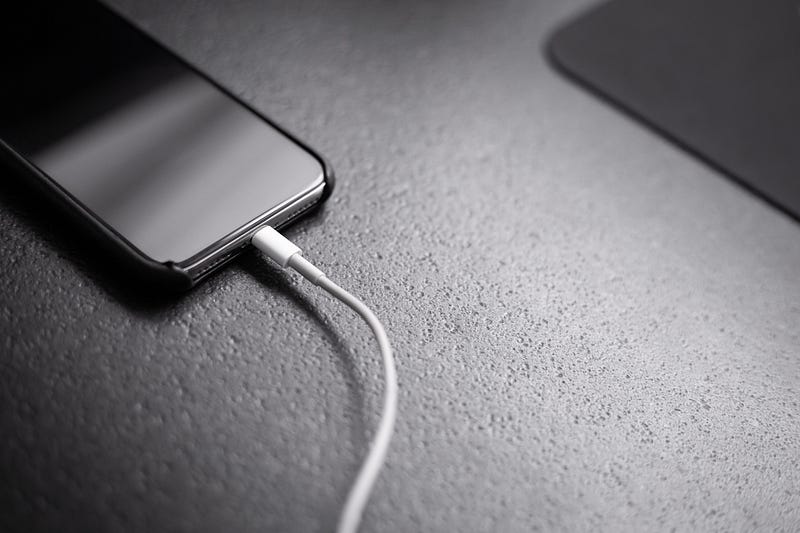Apple's Shift to USB-C: A Necessary Change Amidst Conflicts
Written on
Understanding the Shift: EU Mandates USB-C
Recent legislation from the European Union indicates that Apple will likely transition to USB-C for its upcoming iPhone models. While this could be seen as a positive development, I find myself grappling with mixed feelings.
What’s the Requirement?
The European Union is requiring USB-C to be the universal charging standard for small and medium electronic devices such as smartphones, tablets, and cameras within its jurisdiction. This regulation aims to minimize e-waste and simplify the charging process for consumers, all while promoting technological advancements. As highlighted by Europa.eu, approximately 11,000 tons of e-waste come from discarded and unused chargers each year.

By the end of 2024, all mobile devices in the EU will be required to feature USB Type-C charging ports.
What Will This Mean for Apple?
Even Apple, a leader in the tech industry, must comply with this mandate. By 2024, iPhones and other Apple gadgets sold in the EU will need to support USB-C charging. While there’s a possibility that Apple could create a special USB-C version of the iPhone exclusively for the European market, this seems unlikely. It’s more probable that Apple will adopt USB-C across all new iPhone models globally, benefiting users even in countries like the USA.
However, this change may not sit well with Apple, considering the company has spent the last decade building an accessory ecosystem around the Lightning port. Transitioning to USB-C could disrupt this carefully curated system.
For example, using wired headphones with my iPhone 13 Pro Max requires either a Lightning adapter or a pair of Lightning-connected earbuds. A switch to USB-C would allow for more universal compatibility with existing USB-C headphones, eliminating the need for specialized adapters.
What Does This Change Mean for Users?
The transition from Lightning to USB-C presents a complex scenario for users. On one hand, USB-C introduces a range of connectivity options and enhanced speeds, which could greatly benefit mobile professionals. Users of the iPad Pro have already enjoyed the ability to connect various USB-C peripherals, enhancing their device’s functionality. While it’s uncertain if this transition will bring Thunderbolt or USB 4 capabilities to the iPhone, the potential is certainly there.
On the flip side, many have invested significantly in Lightning accessories over the years, and adapting to USB-C will necessitate purchasing new cables and devices. For tech enthusiasts, this may not be a significant challenge, as many likely have a collection of various cables already.
Nonetheless, this change means users can finally utilize the same cables for charging their MacBooks, iPads, and iPhones. It has often been cumbersome to carry multiple types of chargers for different devices. Furthermore, iPhone and Android users will be able to share charging cables, which should ease the frustration of incompatible chargers during gatherings.
The End of an Era: Farewell to Lightning
Believe it or not, the Lightning port has been a fixture in Apple devices for over a decade. Introduced as a significant upgrade from the cumbersome 30-pin connector, it offered a reversible design that eliminated the hassle of plugging it in incorrectly. However, in a world where high-speed connections like USB-C and Thunderbolt now exist, the Lightning port is becoming obsolete, operating at USB 2.0 speeds (480 Mb/s) — a stark contrast to the capabilities of newer standards.
The 2021 iPad Pro, for instance, boasts a Thunderbolt 3/USB 4 port, capable of speeds up to 40 Gb/s. It’s high time for the iPhone to catch up.
A Concern for Freedom: Government Intervention
While I believe this transition will ultimately benefit Apple users, I am concerned about governmental overreach in mandating how manufacturers should operate. As a business owner, I advocate for free market principles, where consumer choice drives innovation. While I appreciate the EU's intention to reduce e-waste and promote universal charging, I question whether it is appropriate for a government to dictate product specifications.
I would have preferred if Apple had independently recognized the need for USB-C on the iPhone, aligning with the advancements seen in the iPad Pro, rather than being compelled by external regulations.
Should You Wait for a USB-C iPhone?
As the news of a USB-C equipped iPhone emerges for 2024, many are contemplating whether to delay their purchase. The recent release of the iPhone 14 and 14 Pro showcases excellent devices, but there’s no rush to upgrade. The longevity and extended support cycle of iPhones are notable; Apple recently discontinued support for the iPhone 6S, released in 2016.
Unless an upgrade is absolutely necessary, holding onto your current iPhone until the USB-C model is available may be wise. However, if you’re eager for an upgrade, the iPhone 14 remains a solid choice, with the iPhone 15 likely to follow suit in quality, regardless of the charging port.
In conclusion, the best approach is to purchase based on your needs. If you require a new phone now, the current offerings are excellent. If you can wait, it might be worthwhile to see what Apple has in store for the coming years.
The first video titled "Why Apple FINALLY Switched iPhone To USB-C" explores the reasons behind this significant change and its implications for users and the tech landscape.
The second video, "Why I DON'T want a USB-C iPhone 15.. (Apple's Version)," presents a perspective on the drawbacks of this transition, highlighting concerns and potential challenges.